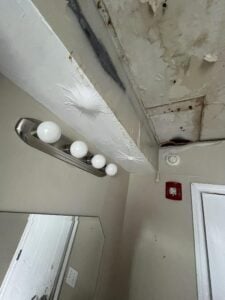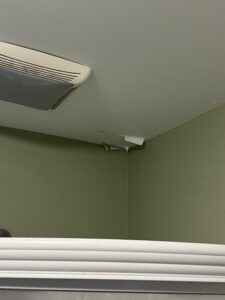Ceiling Water Damage? Here's What to Do Next
 Noticing damp spots, discoloration, or a musty odor on your ceiling? It could be more than just a cosmetic issue. Ceiling water damage is often the first visible sign of a hidden problem, such as a leaking roof, a pipe between floors, or even a malfunctioning HVAC unit in your attic.
Noticing damp spots, discoloration, or a musty odor on your ceiling? It could be more than just a cosmetic issue. Ceiling water damage is often the first visible sign of a hidden problem, such as a leaking roof, a pipe between floors, or even a malfunctioning HVAC unit in your attic.In many cases, by the time ceiling damage becomes noticeable, the leak has been active for a while. The good news is that with prompt action, you can limit further damage and protect your home.
Step 1: Find the Source of the Leak
If you spot water damage on your ceiling, the first priority is identifying where the water is coming from. Start by inspecting your attic for signs of HVAC leaks or condensation. If nothing appears out of place with your HVAC system, your roof may be the next place to check.
Roof leaks are a common cause of ceiling water damage, especially after heavy rains or snow. If you suspect the roof is to blame, it’s best to contact a licensed roofing contractor to inspect and repair the issue.
Step 2: Assess the Ceiling Damage
Once the source of the leak has been repaired, it’s time to address the damage to your ceiling. In most cases, this means removing the affected drywall and replacing it. But before you start cutting, consider the size of the damaged area and whether mold may be present.
Water-damaged ceilings that have been exposed for some time often harbor mold — either on the surface or behind the drywall. This is especially true in humid or poorly ventilated areas. Mold remediation requires the right equipment, safety protocols, and containment methods to prevent cross-contamination throughout your home.
That’s where MacFawn comes in.
Why Professional Restoration Matters:
 Our experienced team at MacFawn Fire & Flood Restoration has the tools, training, and equipment to safely handle ceiling repairs and mold removal.
Our experienced team at MacFawn Fire & Flood Restoration has the tools, training, and equipment to safely handle ceiling repairs and mold removal. We’ll inspect and recommend top-rated mold assessors to evaluate for the full extent of the damage.
Here’s the process:
- Contain affected areas to protect your home.
- Safely remove water-damaged materials.
- Remediate any mold growth.
- Restore your ceiling to its original condition.
Attempting to tackle ceiling repairs on your own can be risky — especially if you’re unsure what’s behind the drywall. There could be electrical wiring, plumbing, gas lines, or structural supports hidden from view. Before cutting anything, it’s essential to perform a safe inspection. If you’re not comfortable doing that, call in the professionals.
When in Doubt, Call MacFawn
Ceiling water damage is more than just a stain — it’s a warning sign. Ignoring it can lead to more extensive repairs, higher costs, and serious health concerns like mold.
If you’ve discovered signs of water damage in your ceiling, contact MacFawn Fire & Flood Restoration for a thorough inspection and professional guidance. We’re here to restore your peace of mind — and your home.

